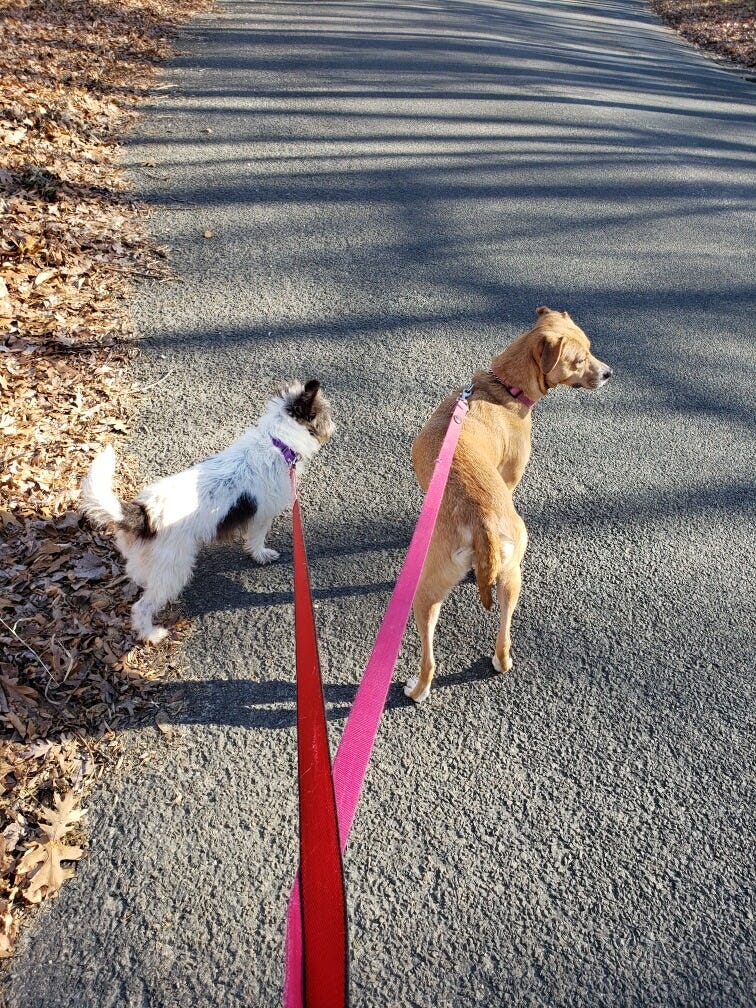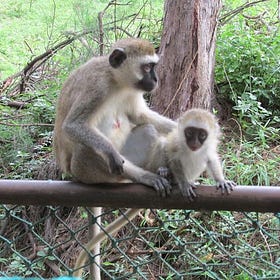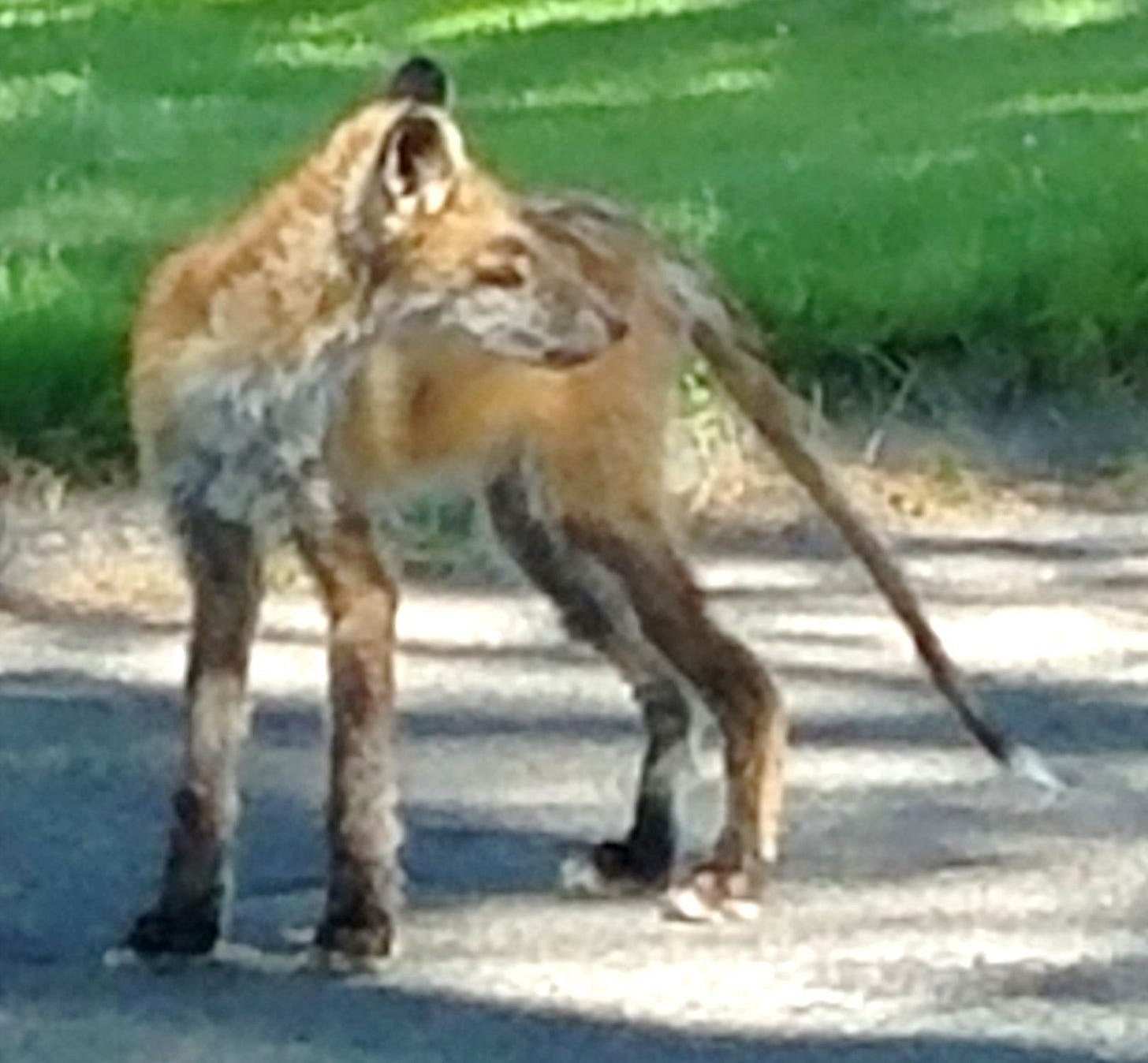The Barkers and Other Neighbors
A walk in my neighborhood takes the familiar and brings it close. Sensory observation is important to setting a scene, but it rarely is the story. Use the writing tips to hone your craft.
In my article,
The Care and Feeding of a Spiritual Writer's Monkeys
William Oncken, Jr.'s Harvard Business Review classic, “Managing Management Time: Who's Got the Monkey?” (1974) outlines ways in which business leaders care for and feed their monkeys. The metaphorical monkeys, of course, are challenges. In 1999, the
I share a list of ten ways to nurture your writing and hone your craft. Number 6 is to take a walk. I have used my own assignment to write the following piece. In this exercise, I take a walk in a familiar place with my dogs and write up my observations. The piece doesn’t need to be written as a story, but can be used as practice to hone your writing skills. An assignment with tips for writing to show (not tell) follows this piece.
I clip a bright pink leash onto Vespa’s collar and a royal purple one on Evie’s and we’re off on a walk through the neighborhood.
Water puddles in the potholes along the curvy, narrow roads from the previous day’s downpour. I walk close to the faded single yellow line in the middle of the street, keeping the dogs on my left out the wet. The air after the rainstorm feels heavy in my lungs and smells of organic pond matter and decaying leaves. The town’s work crew has mowed back the overgrown grass leaving patches of poison ivy in the undergrowth at the edge of the pavement. Where there are no puddles, and no poison ivy that I can see, I let Eve tickle her stocky, terrier-mix belly as she runs through the orange and yellow leaves piling up on the side of the road.
We walk quickly on a stretch of road where long driveways twist their way into the woods to meet up with houses set back into the granite outcroppings, most obscured by mature oak and maple trees, and others completely invisible. Landscaped with rhododendron and mountain laurel, random mostly moss covered stonewalls, tumble in front of dwellings built close to the road as if the stones somehow knew they should stay out of the street and settled where they sit.
The occasional chirp or snap of a twig remind me that the dogs and I are not alone, that the woods are alive with unseen eyes observing our every move. Eighteen years of living in this area and I rarely see humans in this neighborhood. Except for an occasional runner or spandex biker, most people just speed over the empty roads hidden behind their tinted windshields on the way to somewhere else. Attempting to be friendly, I wave to these strangers, my doggy-doo bag clutched tightly in my hand, while fantasizing about speed bumps and other traffic calming devices.
Ambling slowly up a slight hill, letting the dogs pull me, dense woods creep right up to the sides of the road where, on several occasions, we have spotted a long-legged fox. I’m hoping to corroborate the bear sightings and pictures posted on the town’s social media page of a mother bobcat and her babies, but there’s probably scant chance of seeing any wildlife with the howling dogs in a nearby home. These dogs always bark when we pass by, so I’ve named these neighbors The Barkers. Perhaps they’re barking some advice to us, or like my dogs straining at their leashes, and now woofing at the dozens of fearless imposters scampering around the estates with their mouths full of acorns, fluffy tails wagging warnings of the canine intruders. The Barkers just want to get outside and chase some squirrel.
Rounding the bend, two small deer, their faces upturned to a leafy snack, nibble politely at the perimeter of some benefactor’s property. Afraid my dogs will want to engage these soft creatures, especially Vespa, whose small lithe body resembles a bit of Italian Greyhound in appearance and, most importantly, speed, I tighten up on their leashes. Vespa firmly plants her white-socked feet on the tarmac, the short honey-colored fur on her neck standing stiffly at attention. I tug on the leashes gently nudging the dogs to walk away slowly while the deer stare at us and we stare at them. “Good girls!” I say softly in praise—my human voice sounding odd in this ecosystem.
As we head down the hill, I am curious to note the progress of a new house under construction. The house sited high up off the road, an innocuous grey with white trim, is proving to be an unfortunate track mansion—large and imposing with three gaping garages—in an area where centennial homes co-exist with eye-catching modern structures made of glass roofs and shipping containers. The rocky yard has yet to be landscaped, and I wonder if there will be a porch, deck, or anything of architectural interest or just the straight too-narrowly scaled stairs leading to the front door about fifteen feet off the ground. Just then, a black Lexus SUV turns into the gravel driveway and stops, its back tires still in the roadway, and, keeping the engine running, a woman pops out of the driver’s side, runs over to my dogs bends down and gushes, “Oh! I just love dogs!”
“She’s a bit skittish,” I say quickly as she reaches for Vespa. “And Evie has an overbite, so if you pet her, you might feel her teeth,” worried that the woman might think the dog bit her if that happens. “They’re rescues from All Sato Rescue in Puerto Rico,” I explain in case they exhibit any bad manners—it’s not their fault they were abandoned. Both dogs are wagging their tails at the attentions of the middle-aged woman in tight-ish jeans, hair loosely pulled into a brown pony-tail, and hefty diamond ring that glitters and sparkles even on this overcast day.
“My husband and I have had rescue dogs. We just love them,” she says as Vespa leans into the scratching behind her ears shedding her fur all over the lady’s flowy blouse.
“Oh,” I say dully, as if I’m out of the practice of exchanging pleasantries with people. “Are you the owner of this house?” I wonder if these new neighbors might be bringing dogs to live here and hoping they’re not relatives of The Barkers.
“Yes. My name’s Marina, and we have two dogs,” she says, reaching to shake my hand.
“I have a niece named Marina. Your name will be easy for me to remember. Welcome to the neighborhood!” I smile genially and return the handshake.
“Thanks!” and with that, she spins around, gets back into her car, and drives up the driveway into one of the three waiting garages which shutters as it closes her inside.
“Com’on dogs! Good girls!” I start down the hill with a pep in my step. While I’m reveling in the fact that this is the first conversation I’ve had in weeks with anyone in my neighborhood, a flurry of activity catches my eye. A pair of cardinals dart out of some bushes clinging to a precipice and swoop over our heads, chirping excitedly. They look familiar. They might be the same couple that moved out of my backyard since I cut away some of the weeds and brush.
Opening the back door, Vespa and Eve lunge to the water bowl in the kitchen of my cedar shingled farmhouse, built in the late 1890s, which, as the third owner, I gutted and brought up to speed. I retrace my steps down the stone walkway to check the mail, looking up as a whoosh of wings overhead signals a red-tailed hawk coming to rest high in an oak tree. It used to be wild turkeys that favored this tree, but lately the hawks have been hanging out here. I think I’m starting to understand the reason for the ruckus the cardinals were making.
As I navigate what appears to be an underground spring in my lower yard, here comes Matt and Scout from across the street. Matt’s name is easy for me to remember, because it’s my nephew’s name, Marina’s brother. Matt’s mother-in-law was born in their centennial home and over the years they have updated it, adding a deck, an enclosed porch off an addition, and most recently an oversized, two-car garage which now overshadows the house.
“Hey, Scout! What a pretty boy!” I call to the Golden Retriever.
Matt sees the bottom of my driveway, points, and asks, “Have you had a problem with flooding with all this rain?”
“It hasn’t been too bad since I live up on the cliff and the water runs down here, but my driveway looks like inland wetlands!” I respond. “What about you, so close to the marsh there?”
“Yeah, it’s always been bad, but this year it’s just terrible. Just soaking wet.”
“You’ll have waterfront property soon!” I say, and if they cut a few of the reeds down, they could certainly see the tidal river which when flooded looks like a small pond. Scout sniffs around the mailbox, his long, tawny fur a little darker and matted where water and mud from the puddle clings to him.
“Com’on Scout,” Matt says as he pulls on the friendly dog’s leash.
As I near the house, I hear my dogs barking viciously, and I hurry inside. “Stop!” I yell, going over to look out the front window and down at the road in front of the house. “It’s just Scout. You like Scout. He’s a good boy.” But it’s not Scout. It’s my other neighbor, the long-legged fox.
Writing Tips
Walk & Watch Writing Assignment
This assignment will help you to observe the natural world more closely. In turn, your observations will help you write descriptive details that show, not tell the reader how you feel about the place where you’ve taken the walk.
Take a walk. You can choose to spend time in a city park, take a stroll in the woods, or to walk on the beach. This walk should be taken alone or with a pet. If you walk with pets dogs, cats, birds consider how they experience the walk and take notes.
Take notes. You can take photos and video (a selfie stick for unusual angles might be helpful), record sounds, and/or write in a journal.
On your walk, gather sensory information.
SIGHT: Notice the sky, trees, bushes, weeds, manicured lawns, drift wood, stones, the texture of the sand, and other things you can see.
SOUND: Listen for the sounds of animals, the wind in the trees, waves, humans, traffic, and other things you can hear.
SMELL: Sniff the air and breathe deeply to describe the smells of nature, cooking and food, pollution, decay, and other things you can smell.
TASTE: Taste is related to smell. Observe how the air tastes. Notice how the exertion of the walk might leave you thirsty. If you’ve brought food or made a picnic, how does the food taste in this environment?
TOUCH: Describe how things feel to your skin and body—rough, smooth, damp, etc. How does the sand feel on your bare feet or the pebbles under your thin rubber-soled sneakers or the rain on your face?
Write down a list of feelings you had on the walk. You won’t use these words in your writing. In this assignment, you want to consider how things make you feel emotionally, but you will use the sensory detail from your senses instead of telling the reader how you feel. The details you choose will let readers know if you like something, appreciate it, think it’s interesting, or makes you fearful.
In about 500 words, write about your walk. What caught your fancy? Try writing it into a story, scene, or scenario. This may not be something you want to publish but to keep to incorporate into another piece.
Feel free to share your piece below, and thanks for subscribing!








